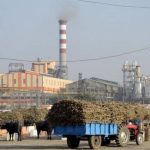HOUSE OF CARDS
It just took a couple of rainy days in Ribeirão Preto and region for the sugar futures market in NY to jump to the higher points seen a few weeks ago again. The weekly fluctuation was powerful, with the contract for July/2023 closing out Friday’s trading session at 26.33 cents per pound, 95 points of accumulated appreciation over the week, equivalent to 21 dollars per ton, but due to the real currency appreciation against the dollar, closing out at the R$ 4.8139 low, presented with a fluctuation of only R$89 per ton against the previous week’s closing. The other futures contracts also appreciated over the week, showing average positive fluctuations of 40 points for the 2024/2025 crop and half of that for the next crop.
The non-index funds increased their long positions. Based on the number released by the CFTC based on last Tuesday’s position, they were long by 193,399 lots. Because since then the market has gone up another 120 points, we believe that the funds might be long by above 200,000 lots.
The Center-South mills are at the limit of sugar they can produce. Most of them “have turned the key” to maximize their production taking the opportunity of the amazing margins that the futures market is showing. Ethanol, however, is going through its bad spell. Petrobras has reduced gas price at the refinery (right when the market was expecting a slight price increase) while the real currency was trading at the lowest level of the last twelve months, a combination of events that knocks down gas price at the pump and pushes forward the return of the consumer in the hydrous supply.
On top of that, corn ethanol availability increases and makes carry over at the end of this crop pretty comfortable. There is no sign of stress in the supply of the product. Demand, on the other hand, continues below the expectations. As the margin of contribution of the product dwindles, it’s reasonable to suppose that the selling pressure on the part of the mills for their additional production will put up a natural barrier in terms of price.
Rarely have we seen the futures market of a particular commodity trade above the cost of production of most exporting countries over a long period of time – such as the case of sugar since April – without there being any rupture of the fundamentals that would account for it.
What puts the market on alert for a continued high is just the climate. A perfect storm that combines the delay in sugar production/delivery, a coverage endorsed by the panic of the end consumers (who actually lost the timing!), and a logistic, port chaos due to the backlog of shipments of the sugar and grain crops. For now, none of that is real. Whether this storm happens or not, it will just delay the market drop in 2024/2025.
Over the last 6 crops, the accumulated total of production until June 1 ended up representing an average of 19.66% of the total production. Based on the numbers released by UNICA, the Center-South has already crushed 125 million tons of sugarcane. Making an easy calculation, the estimated volume would be 635 million tons. Of course, it won’t add up to that, but it should easily come to 600 million tons.
Next year – aware that there will still be a long and winding road way to go – the Center-South should grow in sugarcane volume given that better care with cheaper inputs and cash on hand will be taken. 640 million tons can be an achievable number in addition to this year’s carry-over sugarcane if the mills can’t crush all of the product due to the bad weather.
Regardless of the scenario that we want to build, 2024/2025 emerges as a crop where we will possibly have a world surplus and an increase in the sugar production not only in Brazil but also in other countries. If the energy market stays anemic, sugarcane hydrous will shrink, making room for corn ethanol and more sugar will be available on the market.
The future of the sugar is constructive and will be backed up by the population growth and the consumption per capita in Asia. The world will need about another 11-12 million tons of sugar over the next 5 years and Brazil should be responsible for supplying at least 40% of this volume. Renewable fuels will become more important in the next years (see what is happening in India today). So, it’s impossible not to stay optimistic about the sector. That’s crystal clear to us.
However, high prices are usually bad when they encourage uncontrolled production growth. Markets affected by price increases fed by artificiality usually tumble like a house of cards. In 2005, the then president Lula persuaded a lot of entrepreneurs to invest heavily in ethanol production, since in his megalomaniac vision the country would become the “Saudi Arabia of renewable fuels”. There are mills today that are still paying a high price for the crazy projects encouraged by the braggart president.
We can never forget that in commodities the fundamentals override the narratives. Those who doubt that end up picking up the check for the party they didn’t go to. Not fixing prices can cause a high burden. The best thing is to have the production costs under control, add a pinch of uncertainty and set up degrees of protection that will pay the shareholders appropriately. Believing that a market will go up continuously shows extreme naivety.
You all have a great weekend.
To read the previous episodes of World Sugar Market – Weekly Comment, click here
To get in touch with Mr. Arnaldo, write on arnaldo@archerconsulting.com.br












